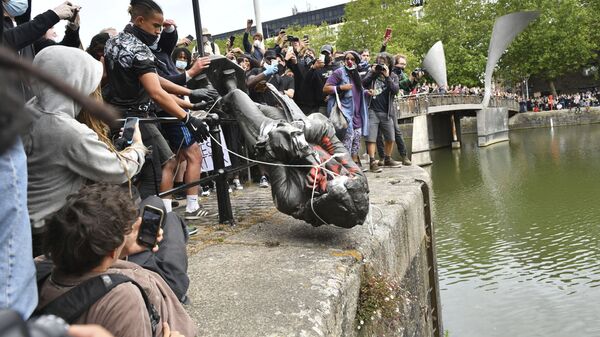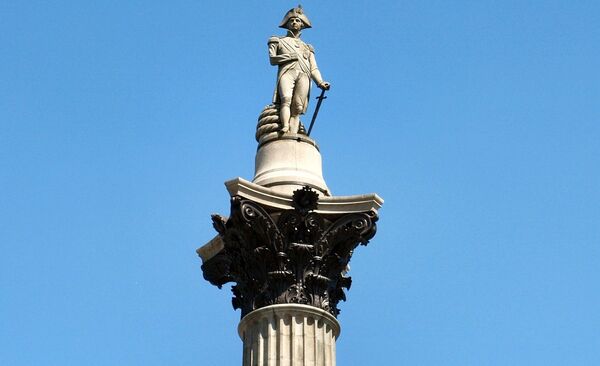Avon and Somerset Police have promised to launch an investigation into the events of Sunday, 7 June, when a crowd of around 10,000 pulled down the statue of Edward Colston, a 17th century slave trader and threw it into Bristol harbour.
The police said they took a “tactical” decision not to intervene but said they were “collating footage of the incident” and suggested they would seek to arrest those involved, who could be prosecuted for criminal damage.
This is the current scene next to the plinth on which Colston’s statue stood until earlier today. pic.twitter.com/gaDLK20U9t
— Martin Booth (@beardedjourno) June 7, 2020
Home Secretary Priti Patel said the removal of the statue was "utterly disgraceful" and policing minister Kit Malthouse said he did not want to see "mobs just turning up and deciding to do whatever they like."
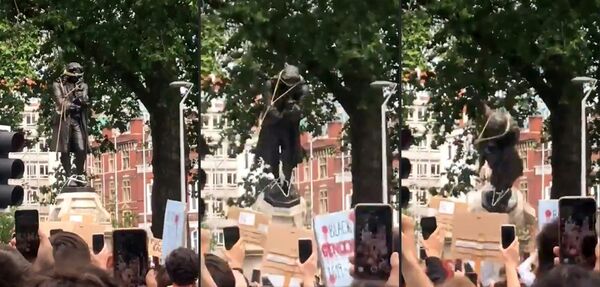
The mayor of Bristol, Marvin Rees - who has Jamaican heritage - said: "I would never pretend that the statue of a slaver in the middle of Bristol, the city in which I grew up, and someone who may well have owned one of my ancestors, was anything other than a personal affront to me.”
The tearing down of statues is not a new phenomenon. Sputnik looks back at when it has happened and when, perhaps surprisingly, statues of controversial figures have been spared.
Edward Colston was responsible for 100,000 people being moved from Africa to the Caribbean as slaves. 20,000 died en route.
— Keir Starmer (@Keir_Starmer) June 8, 2020
The statue shouldn't have been taken down in the way it was. But it should have been removed from our streets a long time ago. pic.twitter.com/1vkhE0khan
Confederate Statues - United States
The Black Lives Matter movement began shortly after the shooting of Michael Brown, an unarmed African-American, by a white police officer in Ferguson, Missouri in August 2014.
In June 2015 Dylann Roof, a white supremacist shot dead nine black people in a Bible study group at a church in South Carolina and it soon emerged that Roof had posted numerous pictures of himself posing with a Confederate battle flag.
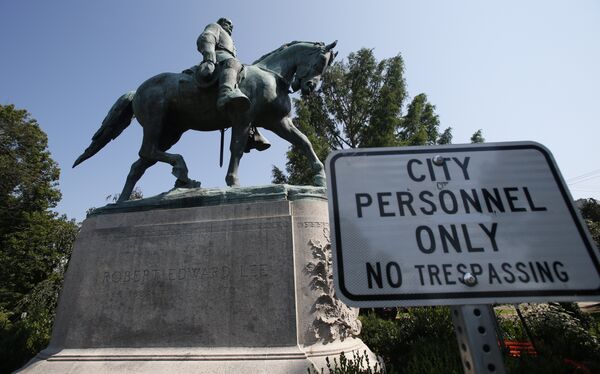
BLM activists began to call for the removal of statues which were associated with the Confederacy - the union of southern, pro-slavery states which was on the losing side during the American Civil War.
Over the next four years dozens of statues of Confederate generals Robert E. Lee, Thomas “Stonewall” Jackson, Nathan Bedford Forrest and former Confederate President Jefferson Davis were removed, usually after a decision taken by the local mayor or city council.
In August 2017 President Donald Trump tweeted: "Sad to see the history and culture of our great country being ripped apart with the removal of our beautiful statues and monuments. You…can't change history, but you can learn from it. Robert E Lee, Stonewall Jackson - who's next, Washington, Jefferson? So foolish!”
But the statues still kept coming down. Last week the decision was taken to remove the Confederate Soldiers & Sailors Monument in Birmingham, Alabama, and on Sunday, 7 June, a statue of General Williams Carter Wickham was torn down by a mob in Richmond, Virginia - the former Confederate capital.
Saddam Hussein - Iraq
In the aftermath of the joint US-UK invasion of Iraq in April 2003 a mob of joyous Iraqis tore down the statue of Saddam Hussein with their bare hands, right?
Wrong.
A joint investigation in 2011 by Pro Publica and the New Yorker magazine discovered the whole thing was a US propaganda stunt, which the western media were happy to go along with because it suited their narrative.

The investigation discovered that despite footage of Firdos Square in Baghdad which was broadcast globally making it look as if there was a huge crowd, in fact the square was largely empty and there were very few Iraqis.
They also learned that a US gunnery sergeant, Leon Lambert, provided the sledgehammer which was used to knock down the statue and the Iraqi flag which was lofted over the plinth was provided by Lieutenant Casey Kuhlman, a US Marine who just happened to be in the neighbourhood.
Stalin - Eastern Europe
Josef Stalin was the leader of the Soviet Union from 1924 - when he succeeded Lenin - until his death 30 years later and led the country to victory during the “Great Patriotic War” against Nazi Germany.
In 1955 - two years after his death - a huge granite statue of Stalin was erected in Prague, the then capital of communist Czechoslovakia.
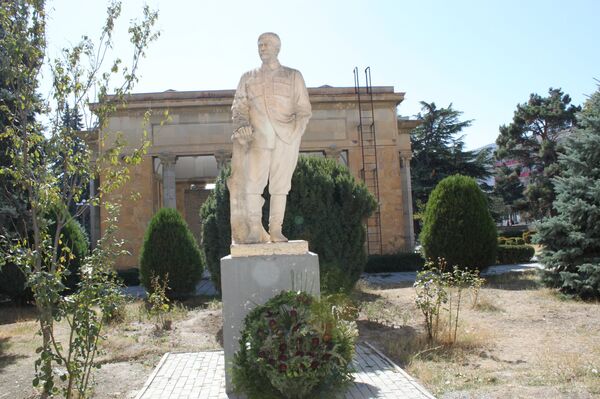
But seven years later it was removed.
In 1956 Stalin’s successor, Nikita Khrushchev gave a speech to the 20th congress of the Communist Party at which he criticised “personality cults.”
Over the next decade statues of Stalin were removed from all over the communist bloc - from East Berlin to Yerevan.
Ironically Albania, which adhered to Stalinist policies long after the Soviet Union, only took down a statue of Stalin in the capital, Tirana, in 1990.
Buddhas of Bamyan - Afghanistan
Although Buddhism is seen as a religion from the Far East, its founder Gautama Buddha, originated in what is now India.
In the 6th century - just as the Prophet Muhammad was founding Islam in Arabia - many people in Central Asia, including modern day Afghanistan, were followers of Buddhism.
They created huge figures in Afghanistan’s Bamyan Valley, close to what was then the Silk Road between Europe and China.

The Buddhas of Bamyan survived for 1300 years and attracted tourists, including Japan’s Empress Michiko who visited in 1971 and was so touched that she wrote a poem about them.
But when the Taliban took control of Afghanistan in the late 1990s they introduced an extremist form of Islam which castigated all other religions.
In 2001 the Taliban decided to blow up the Buddhas of Bamyan, which they saw as idols which offended their puritanical brand of Islam.
Mirza Hussain, a local man who was forced to help the Taliban, later told the BBC: “First they fired at the Buddhas with tanks and artillery shells. But when that was ineffective, they planted explosives to try to destroy them."
Admiral Nelson - Ireland
Ireland was ruled by the English, and then the British Empire, for 300 years until the Irish War of Independence, when Prime Minister David Lloyd George finally conceded to the creation of an Irish Free State.
In 1937 the Free State became the Republic of Ireland but Britain held onto six counties in Protestant-dominated Ulster, which became Northern Ireland.
The Irish Republican Army (IRA) resented the division of Ireland and hated all symbols of British rule.
In 1966 an IRA gang detonated explosives at the top of Nelson’s Pillar in the centre of Dublin.
Fifty years later a member of the gang, Liam Sutcliffe told the BBC: "He was the wrong man, in the wrong place at the wrong time."
The statue - which was almost identical to Nelson’s Column in London’s Trafalgar Square - commemorated British naval hero Admiral Horatio Nelson.
Miraculously nobody was killed or injured but Ireland’s Justice Minister Brian Lenihan said it was "an outrage which was planned and committed without any regard to the lives of the citizens.”
The authorities decided against rebuilding the pillar but plans to replace it with statues of Irish republican heroes Arthur Griffith and Patrick Pearse came to nothing and in 2003 a 120-metre monument, called the Spire of Dublin, was erected.
Sir John MacDonald - Canada
In 2018 the city council in Victoria, British Columbia, decided to remove a state of Canada’s first prime minister, Sir John A. Macdonald from outside city hall.
So what was so controversial about Sir John?
Glasgow-born Macdonald was the first man to unite the western and eastern halves of Canada in the mid-19th century and turn it into a confederation but he also brutally crushed First Nations people and executed Louis Riel, the leader of an uprising by the Métis people in 1885.
He also started the residential schools system, which tore First Nations children away from their parents and sent them to boarding schools where they were “cleansed” of their culture.
Victoria’s mayor, Lisa Helps, said the decision was part of the city’s reconciliation process with First Nations Canadians.
Helps wrote, in the Times Colonist newspaper: “Macdonald shaped one of the greatest nations and strongest democracies in the world. When we look around the world today, we have a lot to be thankful for. Moving the statue does not erase this history.”
Ferdinand Marcos - Philippines
In the 1970s it seemed like a good idea to create a huge bust of the US-backed dictator, Ferdinand Marcos, who appeared set to rule the Philippines forever.
A concrete bust bearing his likeness was erected in 1978 near the peak of Mount Shontoug, overlooking the main highway from Manila to Baguio.
But in 1986 Marcos - whose rule was marked by growing corruption and human rights abuses - was overthrown by "People Power" and was forced to flee to the US with his wife Imelda, who was famous for her enormous shoe collection.
In December 2002 treasure hunters blew the bust up with dynamite while searching for the infamous Yamashita treasure, which they mistakenly believed to be inside.
Andrew Jackson - United States
One of the most controversial presidents in US history is Andrew Jackson, who is universally loathed by Native Americans for actions he took which they perceive as being close to attempted genocide.
Jackson was a strong believer in the policy of “manifest destiny”, which drove the expansion of the United States westwards throughout the 19th century at the expense of the indigenous people, who the president would often refer to as “savages”.
Since we were able to remove a statue, Can we remove Andrew Jackson off the $20?? Replace it with an Indigenous Person on there? Like they always say, Sounds like a nice “Trade” 🙃#BlackLivesMattters #BLM pic.twitter.com/Ad5uFw2ZTt
— Naomi Moon @Migard (@NaomiMoonZ) June 7, 2020
In 1830 Jackson signed the Indian Removal Act, which ordered all Native Americans to be removed from their homelands in Florida, Georgia, Alabama and Mississippi and moved to less fertile land in what is now Oklahoma.
Hundreds of people died along the route of the “Trail of Tears” but their removal made way for thousands of settlers, many of whom farmed the land with their African slaves.
A statue of Jackson - who also owned more than 160 slaves and often brought them to the White House - still has pride of place in Lafayette Square in Washington DC.
There are also statues of Jackson in New Orleans and Nashville and dozens of towns and counties across the US are named after him.

